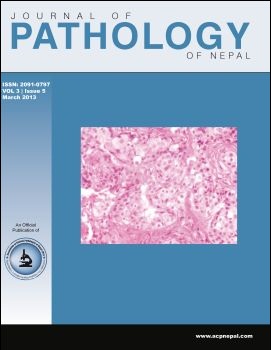Argyrophilic nucleolar organizer regions of thyroid lesions on fi ne needle aspiration smears
DOI:
https://doi.org/10.3126/jpn.v3i5.7859Keywords:
Fine needle aspiration cytology, Nucleolar Organizer Regions, ThyroidAbstract
Background: Argyrophilic nucleolar organizer region is higher in malignant nuclei as compared to reactive and benign nuclei. The main objective of this study was to evaluate the role of Argyrophilic nucleolar organizer region and its extent in differentiating benign and malignant lesions, particularly with respect to follicular neoplasms of the thyroid.
Materials and Methods: This was a prospective, cross sectional study which included 110 patients presenting with thyroid swelling. The fi ne needle aspiration smears were studied by conventional methods and silver staining for Argyrophilic nucleolar organizer region. In 50 cases, diagnosis was confi rmed by histopathology. The Argyrophilic nucleolar organizer region count was done and the mean Argyrophilic nucleolar organizer region count per nucleus was calculated along with pattern of distribution.
Results: Mean Argyrophilic nucleolar organizer region count was higher in neoplastic as compared to non-neoplastic and infl ammatory lesions. Papillary carcinoma had the highest mean Argyrophilic nucleolar organizer region count (5.40 ± 0.86) and the lowest count was seen in Hashimoto’s thyroiditis (2.10 ± 0.36). Higher mean Argyrophilic nucleolar organizer region count was recorded in follicular carcinoma (4.84 ± 1.42) as compared to follicular adenoma (3.5 ± 0.27) which was found to be statistically signifi cant (P<0.05). Argyrophilic nucleolar organizer region dots were arranged in clusters in colloid goiter whereas scattered discrete black dots were seen in neoplastic lesions.
Conclusion: Argyrophilic nucleolar organizer region study of thyroid can be used as an additional diagnostic adjunct with cytomorphological features to differentiate benign and malignant follicular neoplasms.
Journal of Pathology of Nepal (2013) Vol. 3, No.1, Issue 5, 361-366
Downloads
Downloads
Published
How to Cite
Issue
Section
License
This license enables reusers to distribute, remix, adapt, and build upon the material in any medium or format, so long as attribution is given to the creator. The license allows for commercial use.




